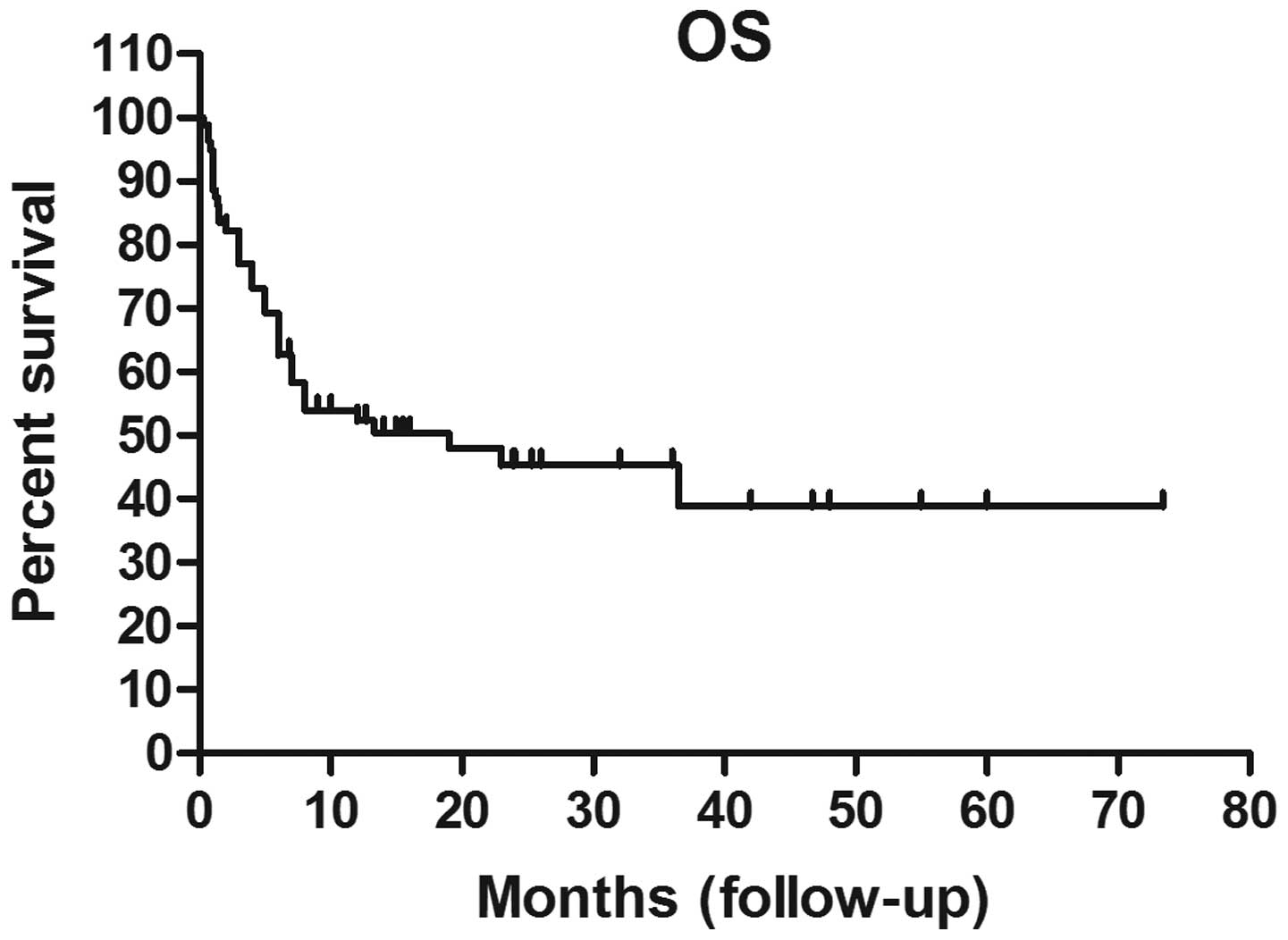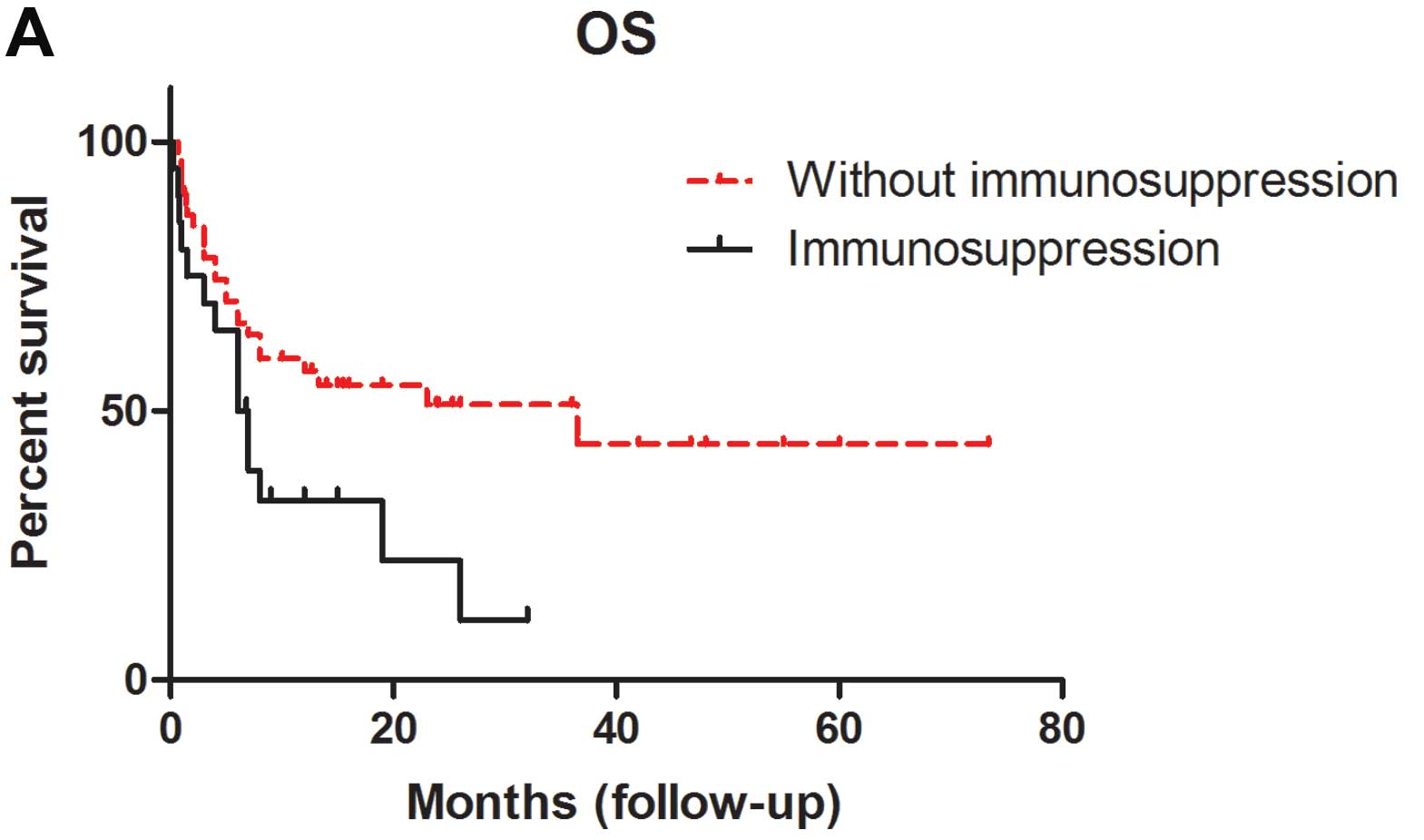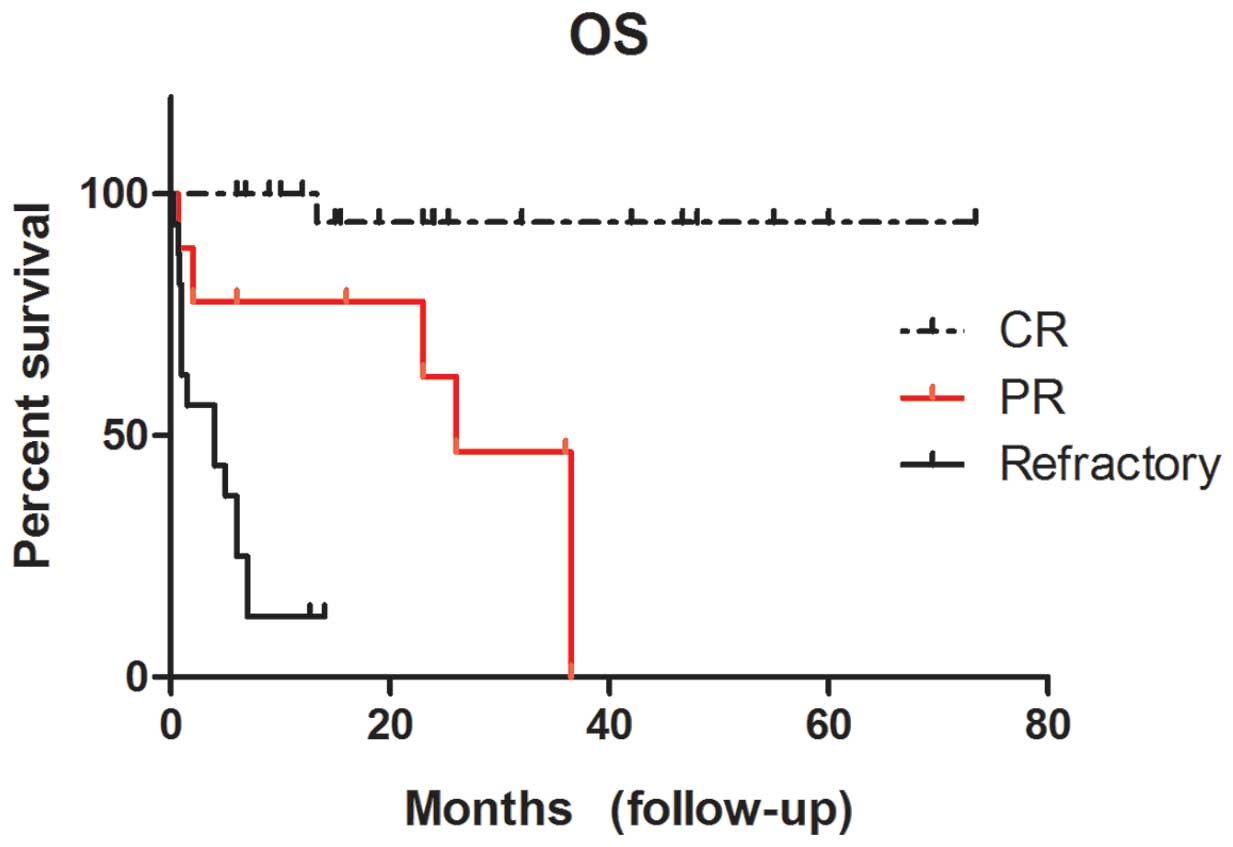|
1
|
Delecluse HJ, Anagnostopoulos I,
Dallenbach F, et al: Plasmablastic lymphomas of the oral cavity: a
new entity associated with the human immunodeficiency virus
infection. Blood. 89:1413–1420. 1997.PubMed/NCBI
|
|
2
|
Castillo JJ, Winer ES, Stachurski D, et
al: Clinical and pathological differences between human
immunodeficiency virus-positive and human immunodeficiency
virus-negative patients with plasmablastic lymphoma. Leuk Lymphoma.
51:2047–2053. 2010. View Article : Google Scholar : PubMed/NCBI
|
|
3
|
Hatanaka K, Nakamura N, Kishimoto K,
Sugino K and Uekusa T: Plasmablastic lymphoma of the cecum: report
of a case with cytologic findings. Diagn Cytopathol. 39:297–300.
2011. View
Article : Google Scholar
|
|
4
|
Tille JC, Pelte MF, Schwartz J, Dietrich
PY and McKee TA: Plasmablastic lymphoma clinically presenting in
the urinary tract. Ann Diagn Pathol. 16:219–223. 2012. View Article : Google Scholar
|
|
5
|
Takeuchi M, Ogawa F, Onishi T and Moriyama
Y: Plasmablastic lymphoma in an elderly immunocompetent patient.
Pathol Int. 62:347–350. 2012. View Article : Google Scholar : PubMed/NCBI
|
|
6
|
Mihaljevic BS, Todorovic MR, Andjelic BM,
Antic DA and Perunicic Jovanovic MD: Unusual presentation of
gastric plasmablastic lymphoma in HIV-negative patient. Med Oncol.
29:1186–1189. 2012. View Article : Google Scholar
|
|
7
|
Zhang LY, Lin HY, Gao LX, et al: Primary
central nervous system plasmablastic lymphoma presenting in human
immunodeficiency virus-negative but Epstein-Barr virus-positive
patient: a case report. Diagn Pathol. 7:512012. View Article : Google Scholar : PubMed/NCBI
|
|
8
|
Lipstein M, O’Connor O, Montanari F,
Paoluzzi L, Bongero D and Bhagat G: Bortezomib-induced tumor lysis
syndrome in a patient with HIV-negative plasmablastic lymphoma.
Clin Lymphoma Myeloma Leuk. 10:E43–E46. 2010. View Article : Google Scholar
|
|
9
|
Khurana A and Jalpota Y: Plasmablastic
lymphoma in a human immunodeficiency virus negative patient. Indian
J Pathol Microbiol. 53:368–369. 2010. View Article : Google Scholar : PubMed/NCBI
|
|
10
|
Heiser D, Müller H, Kempf W, Eisendle K
and Zelger B: Primary cutaneous plasmablastic lymphoma of the lower
leg in an HIV-negative patient. J Am Acad Dermatol. 67:e202–e205.
2012. View Article : Google Scholar : PubMed/NCBI
|
|
11
|
Wang HW, Yang W, Sun JZ, Lu JY, Li M and
Sun L: Plasmablastic lymphoma of the small intestine: Case report
and literature review. World J Gastroenterol. 18:6677–6681. 2012.
View Article : Google Scholar : PubMed/NCBI
|
|
12
|
Tani J, Miyoshi H, Nomura T, et al: A case
of plasmablastic lymphoma of the liver without human
immunodeficiency virus infection. World J Gastroenterol.
19:6299–6303. 2013. View Article : Google Scholar : PubMed/NCBI
|
|
13
|
Brahmania M, Sylwesterowic T and Leitch H:
Plasmablastic lymphoma in the ano-rectal junction presenting in an
immunocompetent man: a case report. J Med Case Rep. 5:1682011.
View Article : Google Scholar : PubMed/NCBI
|
|
14
|
Nguyen DD, Loo BW Jr, Tillman G, et al:
Plasmablastic lymphoma presenting in a human immunodeficiency
virus-negative patient: a case report. Ann Hematol. 82:521–525.
2003. View Article : Google Scholar : PubMed/NCBI
|
|
15
|
Lin F, Zhang K, Quiery AT Jr, Prichard J
and Schuerch C: Plasmablastic lymphoma of the cervical lymph nodes
in a human immunodeficiency virus-negative patient a case report
and review of the literature. Arch Pathol Lab Med. 128:581–584.
2004.PubMed/NCBI
|
|
16
|
Tzankov A, Brunhuber T, Gschwendtner A and
Brunner A: Incidental oral plasmablastic lymphoma with aberrant
expression of CD4 in an elderly HIV-negative patient: how a
gingival polyp can cause confusion. Histopathology. 46:348–350.
2005. View Article : Google Scholar : PubMed/NCBI
|
|
17
|
Scheper MA, Nikitakis NG, Fernandes R,
Gocke CD, Ord RA and Sauk JJ: Oral plasmablastic lymphoma in an
HIV-negative patient: A case report and review of the literature.
Oral Surg Oral Med Oral Pathol Oral Radiol Endod. 100:198–206.
2005. View Article : Google Scholar : PubMed/NCBI
|
|
18
|
Masgala A, Christopoulos C, Giannakou N,
Boukis H, Papadaki T and Anevlavis E: Plasmablastic lymphoma of
visceral cranium, cervix and thorax in an HIV-negative woman. Ann
Hematol. 86:615–618. 2007. View Article : Google Scholar : PubMed/NCBI
|
|
19
|
Hashimoto M, Inaguma S, Kasai K, et al:
Plasmablastic lymphoma of the stomach in an HIV-negative patient.
Pathol Int. 62:763–770. 2012. View Article : Google Scholar : PubMed/NCBI
|
|
20
|
Guan B, Zhang X, Hu W, et al:
Plasmablastic lymphoma of the oral cavity in an HIV-negative
patient. Ann Diagn Pathol. 15:436–440. 2011. View Article : Google Scholar
|
|
21
|
Mansoor M, Alani FS, Aslam MB, Kumar SN,
Sahasrabudhe N and Khan D: A case report of cecal plasmablastic
lymphoma in a HIV-negative patient. Eur J Gastroenterol Hepatol.
24:332–335. 2012. View Article : Google Scholar : PubMed/NCBI
|
|
22
|
Matsuki E, Miyakawa Y, Asakawa S, et al:
Identification of loss of p16 expression and upregulation of MDR-1
as genetic events resulting from two novel chromosomal
translocations found in a plasmablastic lymphoma of the uterus.
Clin Cancer Res. 17:2101–2109. 2011. View Article : Google Scholar : PubMed/NCBI
|
|
23
|
Saraceni C, Agostino N, Cornfield DB and
Gupta R: Plasmablastic lymphoma of the maxillary sinus in an
HIV-negative patient: a case report and literature review.
Springerplus. 2:1422013. View Article : Google Scholar : PubMed/NCBI
|
|
24
|
Marques I, Lagos A and Costa-Neves B:
Gastric plasmablastic lymphoma in HIV-negative patient. Rev Esp
Enferm Dig. 105:166–167. 2013. View Article : Google Scholar : PubMed/NCBI
|
|
25
|
Choi SY, Cho YA, Hong SD, Lee JI, Hong SP
and Yoon HJ: Plasmablastic lymphoma of the oral cavity in a human
immunodeficiency virus-negative patient: a case report with
literature review. Oral Surg Oral Med Oral Pathol Oral Radiol.
117:e115–e120. 2014. View Article : Google Scholar
|
|
26
|
Liu JJ, Zhang L, Ayala E, et al: Human
immunodeficiency virus (HIV)-negative plasmablastic lymphoma: a
single institutional experience and literature review. Leuk Res.
35:1571–1577. 2011. View Article : Google Scholar : PubMed/NCBI
|
|
27
|
Kim JE, Kim YA, Kim WY, et al: Human
immunodeficiency virus-negative plasmablastic lymphoma in Korea.
Leuk Lymphoma. 50:582–587. 2009. View Article : Google Scholar : PubMed/NCBI
|
|
28
|
Qing X, Sun N, Chang E, French S, Ji P and
Yue C: Plasmablastic lymphoma may occur as a high-grade
transformation from plasmacytoma. Exp Mol Pathol. 90:85–90. 2011.
View Article : Google Scholar
|
|
29
|
Suzuki Y, Yoshida T, Nakamura N, et al:
CD3- and CD4-positive plasmablastic lymphoma: a literature review
of Japanese plasmablastic lymphoma cases. Intern Med. 49:1801–1805.
2010. View Article : Google Scholar : PubMed/NCBI
|
|
30
|
Tiong IS, Strauss M, Lau MB and Chiruka S:
Cutaneous plasmablastic lymphoma in an immunocompetent patient with
long-term pyrimethamine use for essential thrombocythemia: a case
report and literature review. Case Rep Hematol.
2013:5417832013.PubMed/NCBI
|
|
31
|
Gogia A and Bakhshi S: Plasmablastic
lymphoma of oral cavity in a HIV-negative child. Pediatr Blood
Cancer. 55:390–391. 2010. View Article : Google Scholar : PubMed/NCBI
|
|
32
|
McGlaughlin KL, Bajel A and Mow CD: A case
of plasmablastic lymphoma harbouring an IgH/MYC translocation in a
HIV negative individual. Pathology. 42:697–699. 2010. View Article : Google Scholar : PubMed/NCBI
|
|
33
|
Cha JM, Lee JI, Joo KR, et al: A case
report with plasmablastic lymphoma of the jejunum. J Korean Med
Sci. 25:496–500. 2010. View Article : Google Scholar : PubMed/NCBI
|
|
34
|
Teruya-Feldstein J, Chiao E, Filippa DA,
et al: CD20-negative large-cell lymphoma with plasmablastic
features: a clinically heterogenous spectrum in both HIV-positive
and -negative patients. Ann Oncol. 15:1673–1679. 2004. View Article : Google Scholar : PubMed/NCBI
|
|
35
|
Colomo L, Loong F, Rives S, et al: Diffuse
large B-cell lymphomas with plasmablastic differentiation represent
a heterogeneous group of disease entities. Am J Surg Pathol.
28:736–747. 2004. View Article : Google Scholar : PubMed/NCBI
|
|
36
|
Borenstein J, Pezzella F and Gatter KC:
Plasmablastic lymphomas may occur as post-transplant
lymphoproliferative disorders. Histopathology. 51:774–777. 2007.
View Article : Google Scholar : PubMed/NCBI
|
|
37
|
Takahashi Y, Saiga I, Fukushima J, et al:
Plasmablastic lymphoma of the retroperitoneum in an HIV-negative
patient. Pathol Int. 59:868–873. 2009. View Article : Google Scholar : PubMed/NCBI
|
|
38
|
Liu F, Asano N, Tatematsu A, et al:
Plasmablastic lymphoma of the elderly: a clinicopathological
comparison with age-related Epstein-Barr virus-associated B cell
lymphoproliferative disorder. Histopathology. 61:1183–1197. 2012.
View Article : Google Scholar : PubMed/NCBI
|
|
39
|
Redmond M, Quinn J, Murphy P, Patchett S
and Leader M: Plasmablastic lymphoma presenting as a paravertebral
mass in a patient with Crohn’s disease after immunosuppressive
therapy. J Clin Pathol. 60:80–81. 2007. View Article : Google Scholar : PubMed/NCBI
|
|
40
|
Verma S, Nuovo GJ, Porcu P, Baiocchi RA,
Crowson AN and Magro CM: Epstein-Barr virus- and human herpesvirus
8-associated primary cutaneous plasmablastic lymphoma in the
setting of renal transplantation. J Cutan Pathol. 32:35–39. 2005.
View Article : Google Scholar : PubMed/NCBI
|
|
41
|
Rao DD, Aggarwal N, Anehosur V, Doddihal
H, Shiraganvi M and Gopalkrishnan K: Plasmablastic lymphoma of the
oral cavity in immunocompetent patients: report of two cases. Int J
Oral Maxillofac Surg. 39:1036–1039. 2010. View Article : Google Scholar : PubMed/NCBI
|
|
42
|
Nicol I, Boye T, Carsuzaa F, et al:
Post-transplant plasmablastic lymphoma of the skin. Br J Dermatol.
149:889–891. 2003. View Article : Google Scholar : PubMed/NCBI
|
|
43
|
Ustun C, Reid-Nicholson M, Nayak-Kapoor A,
et al: Plasmablastic lymphoma: CNS involvement, coexistence of
other malignancies, possible viral etiology, and dismal outcome.
Ann Hematol. 88:351–358. 2009. View Article : Google Scholar
|
|
44
|
Pruneri G, Graziadei G, Ermellino L,
Baldini L, Neri A and Buffa R: Plasmablastic lymphoma of the
stomach. A case report. Haematologica. 83:87–89. 1998.PubMed/NCBI
|
|
45
|
Kravetz JD, Rose MG, Payne-Blackman S and
Federman DG: Plasmablastic lymphoma presenting as an arm mass in an
individual negative for human immunodeficiency virus: a case
report. Clin Lymphoma Myeloma. 6:493–495. 2006. View Article : Google Scholar : PubMed/NCBI
|
|
46
|
Dasanu CA, Bauer F, Codreanu I,
Padmanabhan P and Rampurwala M: Plasmablastic haemato-lymphoid
neoplasm with a complex genetic signature of Burkitt lymphoma
responding to bortezomib. Hematol Oncol. 31:164–166. 2013.
View Article : Google Scholar
|
|
47
|
Miller DV, Mookadam F, Mookadam M, Edwards
WD and Macon WR: Primary cardiac plasmablastic (diffuse large
B-cell) lymphoma mimicking left ventricular aneurysm with mural
thrombus. Cardiovasc Pathol. 16:111–114. 2007. View Article : Google Scholar : PubMed/NCBI
|
|
48
|
Mondal SK, Bera H, Biswas PK and Mallick
MG: High-grade plasmablastic neoplasm of humerus in an HIV-negative
patient, which was indeterminate between plasmablastic lymphoma and
plasmablastic myeloma. J Cancer Res Ther. 7:214–216. 2011.
View Article : Google Scholar : PubMed/NCBI
|
|
49
|
Black CL, Foster-Smith E, Lewis ID, Faull
RJ and Sidhu SK: Post-transplant plasmablastic lymphoma of the
skin. Australas J Dermatol. 54:277–282. 2013. View Article : Google Scholar
|
|
50
|
Ojanguren J, Collazos J, Martínez C,
Alvarez J and Mayo J: Epstein-Barr virus-related plasmablastic
lymphomas arising from long-standing sacrococcygeal cysts in
immunosuppressed patients. AIDS. 17:1582–1584. 2003. View Article : Google Scholar : PubMed/NCBI
|
|
51
|
Montes-Moreno S, Gonzalez-Medina AR,
Rodriguez-Pinilla SM, et al: Aggressive large B-cell lymphoma with
plasma cell differentiation: immunohistochemical characterization
of plasmablastic lymphoma and diffuse large B-cell lymphoma with
partial plasmablastic phenotype. Haematologica. 95:1342–1349. 2010.
View Article : Google Scholar : PubMed/NCBI
|
|
52
|
Saba NS, Dang D, Saba J, et al: Bortezomib
in plasmablastic lymphoma: a case report and review of the
literature. Onkologie. 36:287–291. 2013. View Article : Google Scholar : PubMed/NCBI
|
|
53
|
Robak T, Urbańska-Ryś H, Strzelecka B, et
al: Plasmablastic lymphoma in a patient with chronic lymphocytic
leukemia heavily pretreated with cladribine (2-CdA): an unusual
variant of Richter’s syndrome. Eur J Haematol. 67:322–327. 2001.
View Article : Google Scholar
|
|
54
|
Castillo JJ, Winer ES, Stachurski D, et
al: HIV-negative plasmablastic lymphoma: not in the mouth. Clin
Lymphoma Myeloma Leuk. 11:185–189. 2011. View Article : Google Scholar : PubMed/NCBI
|
|
55
|
Castillo JJ and Reagan JL: Plasmablastic
lymphoma: a systematic review. Sci World J. 11:687–696. 2011.
View Article : Google Scholar
|












